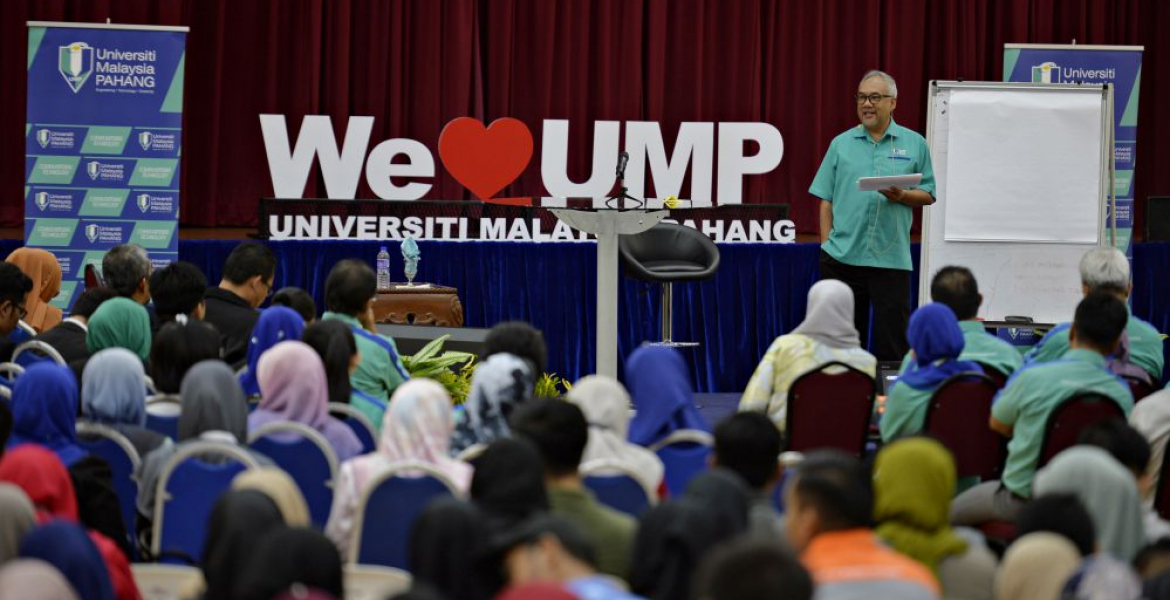UMP targets 4 strategic objectives towards the best technological university by 2050
Universiti Malaysia Pahang (UMP) has laid the foundation in achieving excellence for UMP Strategic Plan 2021–2025 by targetting four main objectives, which are (1) producing holistic community-driven graduates through high-level Technical and Vocational Education and Training (TVET), (2) communitising technology, (3) generating new advanced technologies via research initiatives, and (4) achieving financial and best practices sustainability.
In line with the UMP vision of becoming the best technological university by 2050, the UMP Vice-Chancellor, Professor Ir. Dr. Wan Azhar Wan Yusoff emphasised that the university must have the world-class characteristics and most importantly is to have sustainable financial resources as well as autonomous status.
“With that, we can gather not only students but also lecturers as the world’s first technology specialists.
“It makes UMP well known, and Pekan will be famous someday.
“At that time, UMP is capable of producing highly reputable graduates who are pioneers and sources of reference for global technology and problem solving, and this is the epitome of a university,” he said while implying the future of a university.
He added, “The university management system is also respected, efficient and effective, as well as enhances the dignity of a leading university.
“Therefore, we have to be smart in finding ways to freely strengthen the financial sustainability of RM5 billion target to move independently.
“UMP has a vision of being the best technological university by 2025 with a target of 90% of its lecturers with a doctorate (PhD) degree.
“It can be reflected through reputable and relevant graduates and the service to the global community.”
He also said that UMP currently has over 86% of lecturers with PhD and in realising the target by 2050, the university must develop talent as field specialists in inventing new technologies and developing an efficient, effective and respected management system that optimises talents to uplift the university.
“This expertise will be referred, and programmes to develop the experts will be built,” he said.
Delivering “Amanat Tahunan Naib Canselor 2020” on 15 February 2020, Professor Ir. Dr. Wan Azhar said that based on records of the Ministry of Education Malaysia (MOE), UMP achieved the highest graduate employability status, where 96% of the graduates are employed within 6 months after graduation.
“This target should be maintained in 2025 at a minimum of 90%, but the university must scrutinize those who receive a job offer before graduation.
“The students are not only evaluated academically but also targeted to achieve 80% i-CGPA to possess comprehensive abilities that are built from other skills, which include soft skills such as communication and bilingual, as well as a third language.
“In addition, the university aims to focus on volunteerism, sustainability and environmental care, and other criteria set in X-CGPA,” he said.
He added, “We will also measure the student’s ability through the concept of major–minor.
“For example, engineering students are allowed to enrol in courses from other fields such as business management, problem solving, accounting, psychology, qiraat al-Quran, and many more, as we have lecturers with the said expertise.
“These minor programmes allow technical students to talk about the economy, finance, and those that complement their current courses, by utilising the expertise of UMP lecturers to develop talents and produce holistic and global students.
“In the meantime, UMP will provide an opportunity for the public to join programmes involving industry and academic.”
In increasing the number of collaborations with international universities especially in Germany and China via Dual Degree Award in each faculty, in addition to the partnership with the Karlsruhe University of Applied Science (HsKA) Germany, the collaboration with SIASUN Robot & Automation Co. Ltd. in Shenyang, China, as well as educational institutions in China allows students to complete two years of study in UMP, one year in China and another year for industrial training in SIASUN.
According to Professor Ir. Dr. Wan Azhar, UMP is clustered under the Malaysian Technological University Network (MTUN) to enable the technical capabilities of the country through high-level TVET programmes.
“To enable the capability of communitising technology based on sustainable university–community collaboration, UMP must become an expert in the existing technologies.
“The existence of UMP facilitates the community in understanding building design, control systems, robotics system design, electronic communication system, artificial intelligence, and others.
“The programmes under the Centres of Excellence UMP apply the high-level technology to provide value creation to the community.
“In research, UMP will also increase the research ratio to improve UMP technological capabilities through the Product Development Grant (PDG) Scheme (by department) and Technology Made in UMP (TM@UMP) initiative.
“The university will continue to generate advanced technologies for the community through high-impact research that involve patented intellectual property and invention of new first technology in the world.
“UMP will also increase the reserve percentage (TDI) and improve reasonable operational efficiency towards financial and best practices sustainability.
“With the tagline Communiting Technology, UMP is committed to providing community-driven education, research, and services through social enterprise ecosystem,” he said.
Translation by: Dr. Rozaimi Abu Samah, Faculty Of Chemical And Process Engineering Technology
- 279 views



 Reports by:
Reports by: 






